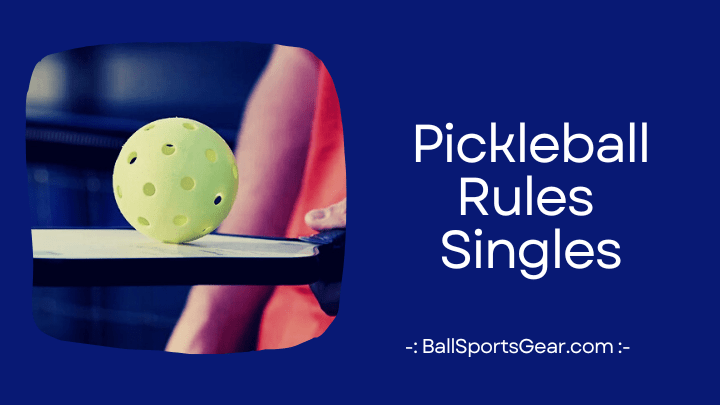From serving to scoring, we have all the tips and strategies you need to dominate your next match. So grab your paddle and let’s learn everything there is to know about singles pickleball rules. Let’s dive in and master the fundamentals of singles pickleball rules – so you can become a true pickleball champion. The first step towards becoming a champion is understanding the rules. Understanding the court structure, scoring system, and game etiquette can help you improve your pickleball game and maximise your potential. So let us go over the regulations and get started. Are you ready to learn how to play pickleball singles? Knowing the rules of this fast-paced game is essential for success on the court, whether you’re a novice or a seasoned pro.
The Object of the Game
Anyone can play pickleball, regardless of experience or athletic ability. The object of the game is to hit a ball over the net and into your opponent’s court for a point. There are no serve-and-volley rules in pickleball – each player serves alternately as Catherine (the server) and Tom (the receiver). You can also score points by hitting the ball over your opponent’s court and into your own, or by passing the ball to an teammate. To start playing, simply find someone to play with – there are always people looking to get some exercise outside! Once you’ve got a partner, there are only a few simple rules to remember.
- Serve by bouncing the ball off the ground two times and then throwing it straight up into the air
- Receiver must hit the ball back over the net, then touch it before it hits the ground again
- After serving, you cannot hit the ball again until after your opponent has served
- Players change sides every four games
Introduction to Pickleball Singles
If you want to start into pickleball singles, this is the post for you! We’ll go over the fundamentals of pickleball singles play in this post. Learn the Basic Pickleball Rules of singles play, such as who serves first and how to score. Understand the strategy and how to position yourself on the court. Finally, practice and refine your technique to become an expert singles player. Improve your pickleball singles game by mastering the fundamentals, understanding strategy, and perfecting your technique. With these skills, you can become an expert singles player. We’ll go through the many types of shots you’ll need to make, how to score points, and some pointers on how to improve your game. So let’s get started.
Additionally, do not be afraid to make unexpected shots – unexpected moves can often result in successful shots. Take advantage of these tips to improve your game and prepare to defeat your opponents. Pickleball singles demands good ball control to avoid going out of bounds or into another player’s court. The second advice is to keep an eye on your opponent. Anticipating where your opponent will strike the ball will keep you from being struck.
Pickleball Rules Singles All You Need To Know
Pickleball is a fast-paced and enjoyable sport that incorporates aspects of tennis, ping pong, and badminton. Players use a Pickleball paddle to strike a little rubber ball across a table to play the sport. The goal of the game is to hit the ball into your opponent’s court and score points by hitting it into their net.
To play singles, each player competes against one other player at a time. There are no Pickleball Doubles Rules – each player plays against one opponent at a time. The games are best three out of five sets. Sets are timed, with 10 minutes per set. If both players have not reached nine points by the end of set number two or three, then those sets are extended to 11 minutes per set.
Finally, if you make an illegal pickleball stroke during either your serve or defense, then your opponent can claim ownership of the ball (a legal pickleball stroke results in possession passing to your partner). There are some crucial guidelines to remember when playing singles. The first rule is that you should never strike your opponent with the Pickleball paddle while they are on defence; this is known as an unlawful pickleball stroke and will result in a penalty point for your team. Second, you are not permitted to contact your opponent’s ball with your hand – this is known as an unlawful pickleball stroke and will result in another penalty point for your side.
Scoring System in Singles Play
The scoring system in singles play is straightforward – each player scores points based on their shots. For every hit that is saved, the server scores one point. If the ball goes out of bounds, the server continues to score until the ball is caught by either player. All other points are awarded to the hitter. The first player to reach 11 points wins the game. This system ensures that each player is always playing to their advantage by forcing them to think strategically about how they will score points. For example, a player may choose to hit a tricky shot to the back corner knowing that their opponent will likely not be able to save it, thus earning them two points as opposed to just one for a more straightforward shot.

Penalties for Rule Violations
A technical foul results in a point for the other side and time off for the offender. Furthermore, if a player willfully violates a regulation with the goal of disrupting their opponent, they may be assessed a “infraction” and ejected from the game. Pickleball has a few penalties that can be imposed at the discretion of the referee. For example, if a player violates a “rule,” their opponent may call “time-out” and deliver a warning. If the rule infringement occurs more than once in a set or match, the referee may call a “technical foul” on the player.
The infractions can include shouting, arguing with the referee, or physically contacting another player, all of which are considered intentional or malevolent. In addition to kicking out the player, an offence may also result in a warning or a point being awarded to the opposing team.
There are a number of punishments that referees may impose to maintain the integrity of the game and ensure participants behave properly and in accordance with the rules of the game. A violation of the rules may result in a warning, a point against the opponent’s team or, in extreme cases, the player being removed from the game.
Playing Tips for Singles
If you’re new to pickleball, these playing tips can help you improve your game.
Keep your eye on the ball
Your goal is to hit the ball into the opposing team’s court and off of the ground, so focus on where it is at all times. Keep your head up and be aware of your surroundings, as an opponent may try to steal your ball. You may shift your body as necessary to strike the ball properly by keeping your head up and your eyes on the ball. Maintaining awareness of your surroundings also helps you spot any possibilities or hazards that may present themselves, like a rival attempting to take the ball. A solid follow-through after the hit is also necessary to guarantee that the ball travels in the intended direction. You may give the ball greater force and precision by following through with your arm and body. Also, it keeps you balanced and keeps you from being unbalanced and open to an adversary’s strike.
Stay low to the ground when hitting balls
Be careful to keep your body low to the ground as you hit a pickleball. By doing this, you can reduce bounce and increase your ability to strike the ball squarely. Also, it increases accuracy since if you hit the ball high in the air, it probably won’t travel very far. Maintaining a low body position also aids in increasing the speed and spin of your shot. This makes it easier to direct the ball where you want it to travel and prevents it from accidentally bouncing off the court. Remaining low to the ground lets you to strike the ball harder and with more control over its trajectory.
Moreover, maintaining a low body position causes the ball to travel faster and spin more quickly, improving accuracy and assisting in keeping it in play. Lowering the body posture improves stability as well, making it simpler to modify the swing. Due to the fact that it will not be impacted by unforeseen changes in the terrain or the weather, this helps to keep the ball in play. Also, a lower centre of gravity results in reduced wind resistance, which helps the ball move farther and quicker.
Be strategic when serving
When serving, be aware of which player is attacking and which player is defending; this will help you determine where best to serve the ball. Try to place it near their feet or in their area so that they have a harder time moving it away from their net. While serving, make an effort to offer the player on the defensive side an edge by positioning the ball there. Their range of possibilities is constrained, and they have less time to respond. This makes it harder for them to move the ball away from their goal, favouring the offensive player. The defensive player is compelled to transfer the ball out of their net and towards the attacking player when the ball is placed in their territory. This provides the attacking player more time to react and get into a more advantageous scoring position.

Frequently Asked Questions
No, you cannot touch or go beneath the net when playing singles pickleball. This will result in a fault, which will earn your opponent a point. The sole exception is if the ball strikes the net and goes over, in which case it is legal to play.ent. The only exception is if the ball hits the net and goes over, in which case you can play it.
In singles pickleball, you get one serve per point. A let serve occurs when the ball hits the net and lands in the proper service court, resulting in a do-over without penalty. However, if the let serve happens on the second serve attempt, it will result in a fault.
Yes, serving position matters in singles pickleball. The server must serve diagonally across the court to the opponent’s service court. The serve must be made behind the baseline and between the centerline and sideline. Failure to comply with these rules will result in a fault.
Conclusions
The Pickleball Rules Singles article offers an in-depth guide to playing the singles format of this adaptive sport. If you’re new to pickleball or need a refresher, keep reading for all the fundamentals. Pickleball is first and foremost played with a paddle and a ball. The goal is to hit the ball into your opponent’s court and then out of play by hitting it into their net. Singles play is governed by eleven fundamental laws.
- A player must keep one hand on the paddle at all times except when hitting the ball.
- A player must hit the ball with his or her non-paddle hand, and may not use any part of the body other than the arm and hand to strike or cause contact with the ball.
- Players cannot push, pull, swat, or throw the ball; they can only hit it with their paddles.
- A player cannot touch either side of their head with their paddle while playing (except when blocking).
- A player cannot stand behind their backwall during serve (or block) unless he or she has first touched both front corners of his or her backwall with his or her front paddles (“touching”). After touching both front corners of his or her backwall, he or she may stand in any location behind his or her backwall without penalty provided he or she makes contact with at least one.

